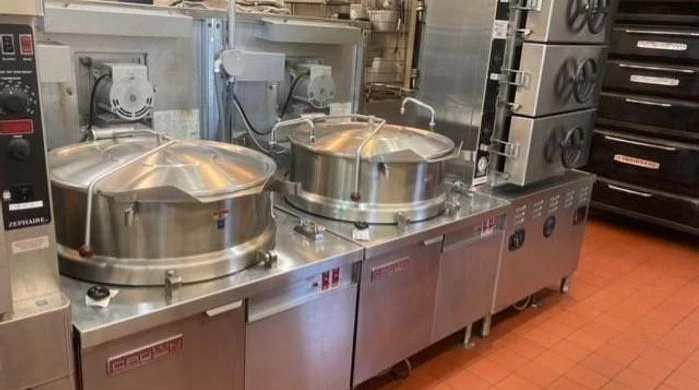Tips on Maintaining Your Commercial Steam-Powered Equipment

By Pat Finley – Master Certified Lead Technician
Steam-powered cooking devices have been around for many years. Commercial steamers and kettles are often used in schools with the aid of a boiler base, but can often be found in larger facilities that have a steam plant for heating and other purposes.
In the restaurant world, the most common is the boiler base unit. It utilizes a boiler to create the pressurized steam needed to heat the steamer cavities and kettles for food preparation. This is done by superheating water with either electric heating elements or gas-fired burners. The water heats up until boiling and then becomes steam.
How it Works
The boiler utilizes pressure switches to control the amount of steam pressure generated. Generally, a high pressure shuts the heat source off once a predetermined pressure is sensed, and a secondary one turns the heat back on once pressure is getting low. These two switches ensure that you have plenty of steam on deck for all of your cooking needs. The steam is transferred via piping or hoses to steam cabinets or kettles, which utilize manual valves or solenoids to control the flow of steam.
What to Watch for with Commercial Steamers
The biggest issue with commercial steamers is water quality. Hardness, chlorides, and other contaminant levels should be tested for your specific location to help determine proper filtration options.
Chlorides can attack metals and weaken the integrity of the boiler.
Limescale buildup inside your boiler can affect it in a multitude of ways. Poor performance from low steam output is the least of the issues. Excessive build-up can cause probes to sense incorrectly, this can be extremely costly. If the unit dry fires, or heats without water, it can blow elements that are costly to repair. Also, limescale can build up and block the drain of the unit. This will cause the unit to not drain properly and be costly to replace the valve.
Importance of General Maintenance
Now let’s get down to your commercial steamer and kettle maintenance. Make sure you are cleaning them.
Commercial steamers are pretty simple, a damp towel with some mild detergent does the trick. Everything cooked in them is generally in a pan and doesn’t really make a mess. You may get some limescale buildup, but if caught early enough, a little vinegar will clean it right up.
Commercial kettles can be used to cook a variety of things and that brings a variety of mess. The great thing is, you have a water source nearby and it can heat it up fast. Once again, mild soap and a green scratch pad should clean up any mess you end up with.
Check your water filter. Most should be dated and I would suggest yearly replacement at a minimum, more if your water quality determines it is necessary. Just because a filter has pressure, doesn’t mean it is fine. The filters can break down internally and let carbon into the system. This in turn can clog orifices and valves.
Check for leaks. Look all around, do you see any water leaks or stains? If so, it may be time for a service call. Visually inspect door seals, they can tear or dry rot over time. Door seals are important as they help create the seal needed to ensure proper cooking. If you notice any steam leaks while the unit is operational, please call for service. Pressurized steam is extremely hot. A steam leak can go from minor to major in a short amount of time. We want everyone to be safe and a steam burn is a dangerous thing.
Most boilers should be flushed regularly after use.
Preventative Maintenance (PM)
Planned maintenance, otherwise known as preventive maintenance, is critical to keeping your commercial steamer or kettle operating at its peak performance. Besides a good checkup of your equipment by a professionally trained service technician, there are certain tasks that should be taken care of.
• Boilers should be descaled at a minimum of twice a year, more often depending on water quality and filtration.
• There are a few components that should be replaced. Gaskets on hand holes and sight glass can deteriorate and cause a leak point.
• Anode, these are a sacrificial metal that is designed to attract sediment and other dangerous elements of the water. This helps extend the life of your boiler.
• Air vents, vent out the cool air in components. This helps let the heat buildup faster. Once it senses a certain temperature, it closes, trapping the heat in the system. If they don’t close, you lose system efficiency and will cause extended run and cooking times.
For more information specific to your commercial steamer or kettle, please reach out to have your equipment inspected by a trained professional. We at General Parts Group would be happy to help, give us a call at 1-888-498-1238 or book a service call here.
